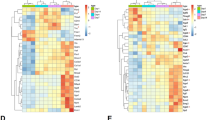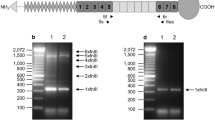Abstract
Purpose
We previously demonstrated that absence of miR-200b results in abnormal lung development in congenital diaphragmatic hernia due to imbalance between epithelial and mesenchymal cells. Tenascin C is a highly conserved extracellular matrix protein involved in epithelial to mesenchymal transition, tissue regeneration and lung development. Considering the involvement of Tenascin C and miR-200b and their potential interaction, we aimed to study Tenascin C during lung development in the absence of miR-200b.
Methods
We collected lungs of miR-200b−/− mice (male, 8 weeks). We performed Western blot (WB) analysis (N = 6) and immunofluorescence (N = 5) for Tenascin C and alpha smooth muscle actin and RT-qPCR for Tenascin C gene expression (N = 4).
Results
Using WB analysis, we observed a decreased total protein abundance of Tenascin C in miR-200b−/− lungs (miR-200b+/+: 3.8 × 107 ± 1 × 107; miR-200b−/−: 1.9 × 107 ± 5 × 106; p = 0.002). Immunofluorescence confirmed decreased total Tenascin C in miR-200b−/− lungs. Tenascin C was significantly decreased in the mesenchyme but relatively increased in the airways of mutant lungs. Total lung RNA expression of Tenascin C was higher in miR-200b−/− lungs.
Conclusion
We report dysregulation of Tenascin C in lungs of miR-200b−/− mice. This suggests that absence of miR-200b results in abnormal Tenascin C abundance contributing to the lung hypoplasia observed in miR-200b−/− mice.



Similar content being viewed by others
References
Khoshgoo N, Visser R, Falk L, Day CA, Ameis D, Iwasiow BM et al (2017) MicroRNA-200b regulates distal airway development by maintaining epithelial integrity. Sci Rep 7:6382. https://doi.org/10.1038/s41598-017-05412-y
Khoshgoo N, Kholdebarin R, Pereira-Terra P, Mahood TH, Falk L, Day CA et al (2019) Prenatal microRNA miR-200b therapy improves nitrofen-induced pulmonary hypoplasia associated with congenital diaphragmatic hernia. Ann Surg 269:979–987. https://doi.org/10.1097/SLA.0000000000002595
Home - miRWalk n.d. http://mirwalk.umm.uni-heidelberg.de/ (Accessed November 8, 2021).
Midwood KS, Chiquet M, Tucker RP, Orend G (2016) Tenascin-C at a glance. J Cell Sci 129:4321–4327. https://doi.org/10.1242/jcs.190546
Mund SI, Schittny JC (2020) Tenascin-C deficiency impairs alveolarization and microvascular maturation during postnatal lung development. J Appl Physiol 128:1287–1298. https://doi.org/10.1152/japplphysiol.00258.2019
Gilpin SE, Li Q, Evangelista-Leite D, Ren X, Reinhardt DP, Frey BL et al (2017) Fibrillin-2 and Tenascin-C bridge the age gap in lung epithelial regeneration. Biomaterials 140:212–219. https://doi.org/10.1016/j.biomaterials.2017.06.027
Chinoy MR, Miller SA (2006) Relevance of tenascin-C and matrix metalloproteinases in vascular abnormalities in murine hypoplastic lungs. Biol Neonate 90:185–196. https://doi.org/10.1159/000093308
Gremlich S, Roth-Kleiner M, Equey L, Fytianos K, Schittny JC, Cremona TP (2020) Tenascin-C inactivation impacts lung structure and function beyond lung development. Sci Rep 10:1–13. https://doi.org/10.1038/s41598-020-61919-x
Akbareian SE, Nagy N, Steiger CE, Mably JD, Miller SA, Hotta R et al (2013) Enteric neural crest-derived cells promote their migration by modifying their microenvironment through tenascin-C production. Dev Biol 382:446–456. https://doi.org/10.1016/j.ydbio.2013.08.006
Yasuda M, Harada N, Harada S, Ishimori A, Katsura Y, Itoigawa Y et al (2018) Characterization of tenascin-C as a novel biomarker for asthma: Utility of tenascin-C in combination with periostin or immunoglobulin e. Allergy Asthma Clin Immunol 14:1–12. https://doi.org/10.1186/s13223-018-0300-7
Lowy CM, Oskarsson T (2015) Tenascin C in metastasis: a view from the invasive front. Cell Adhes Migr 9:112–124. https://doi.org/10.1080/19336918.2015.1008331
Cheng X, Li F, Tao Z (2021) Tenascin-C promotes epithelial-To-mesenchymal transition and the mTOR signaling pathway in nasopharyngeal carcinoma. Oncol Lett. https://doi.org/10.3892/ol.2021.12831
Gonçalves IF, Acar E, Costantino S, Szabo PL, Hamza O, Tretter EV et al (2019) Epigenetic modulation of tenascin C in the heart. J Hypertens 37:1861–1870. https://doi.org/10.1097/HJH.0000000000002097
Chen M, Zhao F, Wang Z, Lang H, Zhang K, Zhang T et al (2020) Low-expression of microRNA-203a in mid-gestational human fetal keratinocytes contributes to cutaneous scarless wound healing by targeting Tenascin-C. Sci Asia 46:133–141. https://doi.org/10.2306/SCIENCEASIA1513-1874.2020.019
Choi YE, Song MJ, Hara M, Imanaka-Yoshida K, Lee DH, Chung JH et al (2020) Effects of tenascin c on the integrity of extracellular matrix and skin aging. Int J Mol Sci 21:1–17. https://doi.org/10.3390/ijms21228693
Unno H, Hasegawa M, Suzuki Y, Iino T, Imanaka-Yoshida K, Yoshida T et al (2020) Tenascin-C promotes the repair of cartilage defects in mice. J Orthop Sci 25:324–330. https://doi.org/10.1016/J.JOS.2019.03.013
Vuckovic A, Herber-Jonat S, Flemmer AW, Roubliova XI, Jani JC (2013) Alveolarization genes modulated by fetal tracheal occlusion in the rabbit model for congenital diaphragmatic hernia: a randomized study. PLoS One 8:1–21. https://doi.org/10.1371/journal.pone.0069210
Acknowledgements
Moritz Markel has a research scholarship (MA 8982/1-1) of the “Deutsche Forschungsgemeinschaft e.V.” (DFG—German Research Foundation); Dr. Richard Keijzer is the Thorlakson Chair in Surgical Research for the Department of Surgery and the University of Manitoba.
Author information
Authors and Affiliations
Corresponding author
Ethics declarations
Conflict of interest
None of the authors have conflicts of interest to declare.
Additional information
Publisher's Note
Springer Nature remains neutral with regard to jurisdictional claims in published maps and institutional affiliations.
Rights and permissions
About this article
Cite this article
Markel, M., Tse, W.H., DeLeon, N. et al. Tenascin C is dysregulated in hypoplastic lungs of miR-200b−/− mice. Pediatr Surg Int 38, 695–700 (2022). https://doi.org/10.1007/s00383-022-05096-0
Accepted:
Published:
Issue Date:
DOI: https://doi.org/10.1007/s00383-022-05096-0




